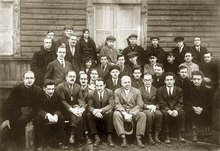Central design office
The Central Design Office ( ZKB , Russian центральное конструкторское бюро , Zentralnoje Konstruktorskoje bjuro) is a former Soviet development department for aeronautical engineering. In the 1920s and 1930s, the ZKB, together with the ZAGI, was responsible for building up Soviet aviation. Several successful designs such as the U-2 multi-purpose aircraft and the I-16 fighter aircraft were developed at the ZKB .
history
The Central Design Office was formed in 1925 from the technical department of ZAGI in Plant 1 in Moscow. It was subdivided into the department for land aircraft construction "OSS" (otdjel suchoputnich samoljotow) and the department for experimental seaplane construction "OMOS" (otdjel morskowo opytnowo samoljotostrojenija).
The OSS was headed by Nikolai Polikarpow and soon moved to Plant 25. By 1926, a tribe of young employees had developed who later became known for their designs, such as Vasily Nikitin , Mikhail Tichonrawow , Vladimir Jazenko and Sergei Kotscherigin . The most famous aircraft of this team are the fighter I-3 and the multi-purpose aircraft U-2 and R-5 .
In the summer, OMOS started work at the Leningrad plant “Roter Flieger” (Krasni Lotschik) under Dmitri Grigorowitsch . In October of the same year, OMOS became an independent development office. Important members at OMOS were:
- Deputy head: AN Sedelnikow
- Production management: WL Korwin
- Aerodynamics and strength: KA Wigand, WN Beljajew (only briefly), A. L. Gimmelfarb, S. J. Schurbina
- Construction: PD Samsonow, WB Schawrow
- Technical drawing: NG Michelson
OMOS moved from Leningrad to Moscow in November 1927 and was renamed "OPO-3", "Experimental Department 3" (Opytni Otdjel). From 1925 to 1927 eight types were realized, including the R-1 version MR-1 equipped with floats and the naval reconnaissance aircraft ROM-1 and ROM-2. Two projects were not implemented. Since the department could not show any notable successes after three years of work, it was reorganized and Grigorowitsch was deposed on September 1, 1928. Some new employees were hired, including Igor Cheetverikov . Under his leadership, work on the MR-3 and MR-3bis flying boat projects continued. In the spring of 1929, the Frenchman Paul Richard, who had come to the Soviet Union, took over the entire department under the designation "OPO-4" (later MOS WAO) and designed the TOM-1 floatplane. The projects developed up to then were transferred to the ZKB plant “W. R. Menschinski ”for completion.
In 1933 the ZKB was spun off from the ZAGI and the employees were integrated into the newly created design offices of Polikarpow, Ilyushin and Grigorowitsch. The aircraft carried the abbreviation ZKB as a prototype name until 1938, such as the successful models ZKB-3 ( I-15 ), ZKB-12 ( I-16 ), ZKB-26 ( DB-3 ) and ZKB-55 ( Il- 2 ).
See also
literature
- Wilfried Copenhagen : Lexicon Soviet Aviation . Elbe-Dnjepr, Klitzschen 2007, ISBN 978-3-933395-90-0 .
- Wadim B. Schawrow: Airplane constructions in the years of socialist industrialization . In: Aviator Calendar of the GDR 1976, 1981 and 1982 . Military publishing house, Berlin.

